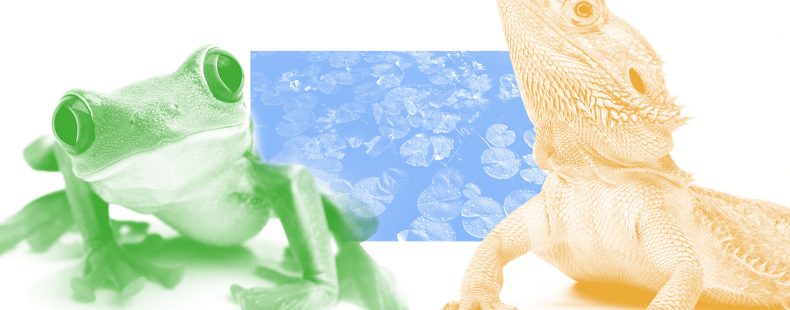Reptiles vs. Amphibians: it sounds like a monster movie title, but it’s a classic question of animal classification. Although both are cold-blooded vertebrates and the two are often mistaken for each other, there are some key differences.
Many people think the difference is whether or not an animal spends some time in water, but it’s more complicated than that.
In this article, we’ll explain how the difference usually involves two main distinctions: where eggs are laid (on land or in water) and skin type (scaly or not). We’ll provide several examples of both reptiles and amphibians and reveal which category snakes, lizards, turtles, and frogs fall under.
⚡ Quick summary
Reptiles are born with lungs, typically lay their eggs on dry land, and have scaly skin. Most amphibians are born with gills but later develop lungs, typically lay their eggs in water, and have thin, moist skin (without scales). Reptile eggs are fertilized internally, while amphibian eggs are usually fertilized after being laid in water.
What is a reptile?
Animals classified as reptiles (scientific class Reptilia) are distinguished by several key characteristics. Reptiles belong to the taxonomic group of animals known as vertebrates, and they are cold-blooded, meaning they can’t regulate their own body temperature—their blood temperature matches the temperature of the environment. Reptiles have lungs and an outer covering of horny scales or plates. They usually lay their eggs on dry land.
Examples of reptiles
Here are some common examples of reptiles:
- snakes
- lizards (including geckos and chameleons)
- crocodiles and alligators
What are amphibians?
Amphibians (scientific class Amphibia) are also cold-blooded vertebrates. Amphibian eggs are laid in water and are usually fertilized after being laid (rather than the other way around). They hatch in water as aquatic larvae. They are born with gills that allow them to breathe underwater, where they spend their early development. But as most species develop into adults, they undergo a metamorphosis, developing four legs and lungs and becoming more terrestrial (meaning they spend a lot of their time on land). Amphibians are smooth-skinned—they do not have scales.
Think of how frogs begin life as tadpoles: they spend their early period underwater with gills and tails, and then develop legs and move out of the water to spend time on land.
Some amphibians are shaped like lizards but aren’t really lizards—and they don’t have scales.
Examples of amphibians
Here are some common examples of amphibians:
- frogs
- toads (don’t let their bumpy skin fool you—those aren’t scales)
- salamanders, newts, and axolotls (they may be shaped similar to lizards, but they don’t have scales)
Are turtles reptiles or amphibians?
Turtles are often found in many of the same habitats as snakes (which are reptiles) and frogs (which are amphibians). Many turtle species switch between land and water, a classic amphibian trait, and, like many amphibians, some turtles have smooth-looking skin. Turtles are, however, reptiles: with the exception of one species, turtles lay their eggs on land—think of how even sea turtles crawl ashore to deposit their eggs in the sand. Turtles’ eggs are fertilized before being laid, and, despite the appearance of some turtles, they do have scales.
But do you know the difference between a turtle and a tortoise? Learn about them here.
Where do the words reptile and amphibian come from?
Amphibian comes from the Greek amphi-, meaning “both,” and bios, “life”—a reference to the fact that they spend their lives both on land and in the water. Reptile comes from the Latin reptilis, meaning “creeping”—a description of the creeping movement of reptiles like snakes and lizards.
What’s the difference between reptiles and amphibians?
Although reptiles and amphibians are both cold-blooded vertebrates, there are significant differences in their characteristics and life cycles. Reptile eggs are fertilized internally and usually laid on dry land, while amphibian eggs are fertilized after being laid in water. Reptiles are born with lungs, while amphibians are born with gills for breathing under water—where they hatch and spend their early development (growing lungs and legs later). Reptiles have scales, while amphibians have thin, smooth skin. Snakes, turtles, and lizards are reptiles. Frogs, toads, salamanders, and newts are amphibians.














